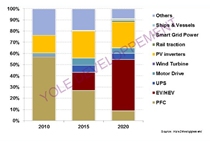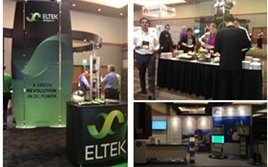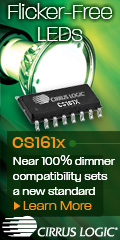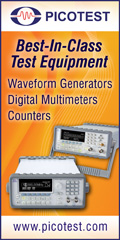 |
IN THIS ISSUE:
» From the Editor's Desk
» Frequency-Foldback Technique Optimizes PFC Efficiency Over The Full Load Range
» Techniques For Implementing A Positive And Negative Output Voltage For Industrial And Medical Equipment
» Process, Packaging Combine To Advance High-Voltage Power MOSFETs
» Semiconductors In The Efficiency Era:
Is Silicon Carbide Technology Ready To Take Off?
» Special Report:
INTELEC Bridges The Telecom And Energy Worlds
» New Power Products
» Other Top Power News
From the Editor's Desk David G. Morrison
Editor, How2Power TODAY
|
|

Discussions about the potential of gallium nitride (GaN) and silicon carbide (SiC) technologies have been ongoing for some time now. But as more semiconductor manufacturers enter this field, and as more GaN and SiC power devices become available, these discussions become more practical and more relevant to a growing number of engineers. Because this field is rather dynamic, designers need to keep track of the current state of these two semiconductor technologies, particularly what’s happening in the marketplace, while also learning what developments are just over the horizon. Starting this month, Ashok Bindra will explore these issues and more in his column, “Semiconductors in the Efficiency Era,” where he will report and comment on the latest advances in power semiconductor technology and devices. Sponsored by Cree and EPC, this column will address not only GaN and SiC developments, but also the continuing evolution of silicon power discretes and modules. Meanwhile, in other parts of the newsletter, we’ll continue to bring you in-depth discussions of design techniques and advanced control methods, as in this month’s feature by Joel Turchi on a novel control method for improving the efficiency of PFC power stages. This issue also brings you effort-saving options for implementing positive and negative supply rails; a feature on high-voltage power MOSFETs; new power components and tools; and Kevin Parmenter’s report from INTELEC 2012. As a bonus, you will also get a chance to win a copy of Christophe Basso’s new book on designing power supply control loops.
|

HOW2POWER EXCLUSIVE DESIGN ARTICLES 
|
Frequency-Foldback Technique Optimizes PFC Efficiency Over The Full Load Range
by Joel Turchi, ON Semiconductor, Toulouse, France.
“Green requirements” such as 80 PLUS aim to maximize power supply efficiency across a range of load conditions. So it has become critical that power supply designers address medium- and light-load efficiency in the PFC power stage. A popular approach to lowering losses under lighter load conditions is to reduce the switching frequency (frequency foldback.) While extremely efficient at very low power, this solution must be carefully implemented at intermediate power levels. This article clarifies how the switching frequency should be managed in a PFC boost converter to maximize efficiency across the load range. The converter’s MOSFET losses are analyzed under critical-conduction and discontinuous-conduction modes of operation. Then the operating principles for a relatively new method of frequency reduction, known as current-controlled frequency foldback (CCFF), are explained. This article also discusses the operation of controllers using CCFF and presents experimental results.
Read the full story…
|

Instead of computing the switching losses of a PFC boost converter directly, this article describes an easier approach—predicting the trend in DCM losses as a function of CrM losses, with respect to switching frequency reduction |


A variation on the flyback converter, the Fly-buck generates split-rail voltages with isolation, yet needs no optocoupler since it uses primary-side feedback. |
Techniques For Implementing A Positive And Negative Output Voltage For Industrial And Medical Equipment
by Rich Nowakowski, Texas Instruments, Dallas, Texas
Many analog circuits in industrial and medical applications require both positive and negative supply voltages. A discrete switching regulator is often used to derive both positive and negative output voltages, but implementing an inverting buck-boost topology with a coupled inductor can be burdensome. However, recent advancements in dc-dc modules allow straightforward implementation of a split-rail power solution. This article surveys several discrete and module-based negative output and split-rail positive and negative output solutions for powering split-rail amplifiers, analog sensors, data converters, and audio amplifiers. Key factors such as complexity, component count, relative cost, and performance are explored. Read the full story… |

Process, Packaging Combine To Advance High-Voltage Power MOSFETs
by Vipin Bothra, STMicroelectronics, Schaumburg, Ill.
There’s a significant amount of design activity today in power management involving voltages between 400 V and 1700 V, with the bulk of interest around 600 V at 2 kW. Applications include switched-mode power supplies, motor control, industrial machines, hybrid electric vehicles, and many others. Market pressures to make these end products smaller and more efficient place tremendous demands on the power components, especially the power MOSFETS. In response MOSFET vendors are improving the performance of their devices through advances in their process technology and packaging. This article discusses two examples of recent advances by STMicroelectronics—the MDmeshV process and the HV PowerFLAT 8×8 package. Data is presented to illustrate the improvements in device performance made possible by these innovations.
Read the full story…
|

Package thickness is increasingly important with today's tight pc-board layouts and spacing |


 |  |


SEMICONDUCTORS IN THE EFFICIENCY ERA 
Sponsored by Cree and Efficient Power Conversion
A monthly column discussing the latest advances in power semiconductor technology and devices |

Is Silicon Carbide Technology Ready To Take Off?
by Ashok Bindra, Technology Writer, Technika
Despite gains made in silicon carbide (SiC) technology, it continues to represent a very small percentage of the overall power semiconductor market. By some accounts, it could be less than 1%. But, going forward, the situation looks a lot brighter. With both SiC MOSFETs and diodes now available, and wafer makers continuing to deliver high-quality substrate materials while increasing the diameter, SiC is poised for rapid growth in the next five to ten years as usage proliferates in applications ranging from PFCs and UPSs to solar inverters to EVs/HEVs, motor drives, and others. Read the full story…
|

As SiC product portfolios expand and costs drops, these devices will expand into solar power
inverters, motor drives, and many other
applications in the next five to 10 years. |


Special Report  |

INTELEC Bridges The Telecom And Energy Worlds
by Kevin Parmenter, Contributor, How2Power Today
Exploring this year’s International Telecommunications Energy Conference, Kevin Parmenter discovered just how much the telecom power industry has changed over time. An industry that was once focused on ac-dc rectifiers and batteries for central offices now encompasses a range of energy- and power-related technologies to support a diverse telecom infrastructure, which often lacks access to a stable power grid. As Kevin explains in this special report, INTELEC 2012’s exhibition, conference program, and audience reflected this reality. For more details… |

The INTELEC 2012 exhibit included suppliers of a
wide range of telecom power-related products. |

 — POWER PRODUCTS IN 3 IMAGES OR LESS — POWER PRODUCTS IN 3 IMAGES OR LESS 
|
 |

CamSemi’s C2283 primary-side
sensing flyback controller.
|
PSS Flyback Controller Eyes Low-Cost Networking Adapters
 Diagram: A typical application circuit for a 12-V, 1-A networking adapter using the C2283, a primary-side sensing flyback controller with a constant-power mode. Diagram: A typical application circuit for a 12-V, 1-A networking adapter using the C2283, a primary-side sensing flyback controller with a constant-power mode.
 Graph: V-I output characteristics of a 12-V, 1-A adapter. The controller regulates in constant-current mode when output voltage is above VSHUTDN(max) and until it is above approx. 50% of the programmed constant-voltage regulation point. Graph: V-I output characteristics of a 12-V, 1-A adapter. The controller regulates in constant-current mode when output voltage is above VSHUTDN(max) and until it is above approx. 50% of the programmed constant-voltage regulation point.
 Drawing: The C2283 comes in surface-mount SOT23-6 package. Drawing: The C2283 comes in surface-mount SOT23-6 package.
More details… |


Picotest.com’s J2112A fast current injector.
|
Current Injector Outperforms Electronic Loads In Measuring POLs
 Photo: Picotest.com’s J2112A fast current injector is a higher-current version of the J2111A. The new injector offers greater current range (1 A vs. 100 mA) while improving rise/fall times down to 10 ns and achieving >40-MHz bandwidth. Photo: Picotest.com’s J2112A fast current injector is a higher-current version of the J2111A. The new injector offers greater current range (1 A vs. 100 mA) while improving rise/fall times down to 10 ns and achieving >40-MHz bandwidth.
 Waveforms: The company put its J2112A current injector to the test in measuring the step-load response of a buck regulator that switches at 20 MHz. Waveforms: The company put its J2112A current injector to the test in measuring the step-load response of a buck regulator that switches at 20 MHz.
 Photo: To test the buck regulator, the J2112A is connected to an eval board via a BNC-to-SMA adapter. Achieving the fast response requires very low interconnect inductance. Photo: To test the buck regulator, the J2112A is connected to an eval board via a BNC-to-SMA adapter. Achieving the fast response requires very low interconnect inductance.
More details… |

 Efficient Power Conversion’s EPC9003 Efficient Power Conversion’s EPC9003
and EPC9006 development boards.
|
Development Boards Simplify Evaluation Of eGAN FETs
 Photo: The EPC9003 and EPC9006 development boards are primarily output power stages with each board containing two eGAN transistors in half-bridge configuration along with the driver IC optimized for eGAN devices. Photo: The EPC9003 and EPC9006 development boards are primarily output power stages with each board containing two eGAN transistors in half-bridge configuration along with the driver IC optimized for eGAN devices.
 Graph: All the critical components, including gate-drive supply and bypass capacitors, are incorporated on this 2- x 1.5-inch board with proper layout for optimal switching and easy connection to any existing converter. Graph: All the critical components, including gate-drive supply and bypass capacitors, are incorporated on this 2- x 1.5-inch board with proper layout for optimal switching and easy connection to any existing converter.
More details… |
Win A Free Copy Of Book On Loop Control
In the September issue, the newsletter introduced Christophe Basso’s new book “Designing Control Loops for Linear and Switching Power Supplies: A Tutorial Guide." Now, we’re giving you a chance to win one of five free copies of this book, courtesy of the publisher, Artech House. To enter this drawing, simply email us at bookcontest@how2power.com. Please write “Basso’s book” in the subject line of your email and include your name in the body of the email. Only one email per person and all entries must be received by November 10, 2012. |

|

MORE POWER PRODUCTS:
• PFC Controller Integrates Numerous Protection Features More details…
• High-Speed 600-V IGBTs Feature Very Low Saturation Voltage More details…
|
|






|

 |
 |

OTHER TOP POWER NEWS |

- At INTELEC 2012, Vicor participated in a demo of a higher-voltage (400 V dc) power distribution system for telecom and datacenter applications, highlighting the benefits and feasibility of such a system using commercial-grade, ETSI EN 300 132-3-1-compliant hardware. To watch a video replay and to access the related whitepaper, see http://www2.vicorpower.com/intelec2012.
|



ABOUT THIS NEWSLETTER: Thank you for reading HOW2POWER TODAY.
How2Power sends no more than one e-mail per month to registered users. Continuing your subscription ensures you'll receive future newsletters. Manage Your Subscription
©2012 All rights reserved. www.how2power.com
|